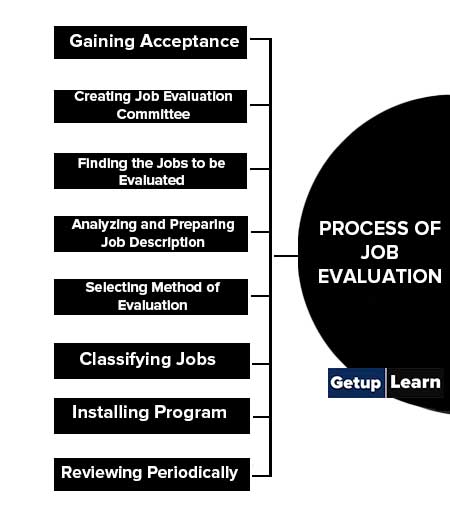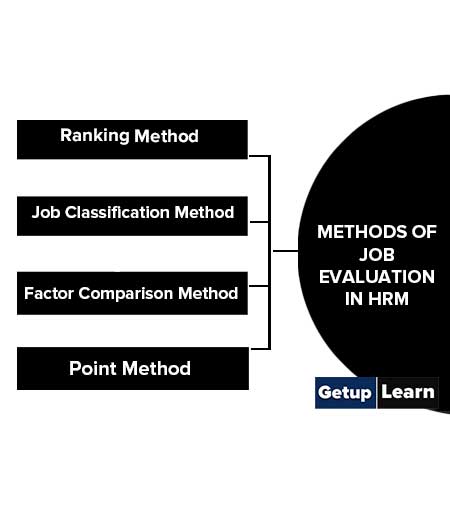- 3.1 Gaining Acceptance
- 3.2 Creating Job Evaluation Committee
- 3.3 Finding the Jobs to be Evaluated
- 3.4 Analyzing and Preparing Job Description
- 3.5 Selecting Method of Evaluation
- 3.6 Classifying Jobs
- 3.7 Installing Program
- 3.8 Reviewing Periodically
- 4.1 Ranking Method
- 4.2 Job Classification Method
- 4.3 Factor Comparison Method
- 4.4 Point Method
- 8.1 Establishing Fair Pay
- 8.2 Facilitating Promotions and Transfers
- 8.3 Improving Communication
- 8.4 Identifying Training Needs
- 8.5 Improving Morale
- 8.6 Facilitating Succession Planning
- 8.7 Ensuring Compliance
- 10.1 What is job evaluation in HRM?
- 10.2 What is the meaning of job evaluation?
- 10.3 What is the process of job evaluation?
- 10.4 What are the methods of job evaluation?
What is Job Evaluation?
Job evaluation aims to provide this equity and consistency by defining the relative worth of different jobs in an organization. Job evaluation is the process of determining the relative worth of different categories of jobs by analyzing their responsibilities and consequently, fixation on their remuneration.

Job evaluation is a system of determining the relative worth of different jobs in an organization. Here a particular job of an enterprise is compared with its other jobs. Comparative study of these jobs is very necessary because on the basis of such study the structure of wages for different types of jobs is prepared. The value of each job depends on certain factors.
In other words, Job evaluation is the process of establishing the value of jobs in a job hierarchy. Job evaluation is a formal and systematic comparison of jobs in order to determine the worth of one job relative to another so that a wage or salary hierarchy results.
It is a process by which jobs in an organization are appraised. Job evaluation begins with job analysis and ends up with the classification of jobs according to their worth. The purpose of job evaluation is to determine the basic wage rates for different jobs.
Definition of Job Evaluation
These are some definitions of job evaluation given by the authors:
[su_quote cite=”Kimball and Kimball”]Job evaluation represents an effort to determine the relative value of every job in a plant and to determine what the fair basic wages for such a job should be.[/su_quote]
[su_quote cite=”Edwin B. Flippo”]Job Evaluation is a systematic and orderly process of determining the worth of a job in relation to other jobs’. He further said that the objective of this process is to determine the correct rate of pay. It is therefore not the same as job analysis. Rather it should follow the job analysis process, which provides the basic data to be evaluated.[/su_quote]
[su_quote cite=”Wendell French”]Job evaluation is a process of determining the relative worth of various jobs within the organization, so that different wages may be paid to jobs of different worth”. The relative worth of a job means the relative value produced. The variables which are considered for value produced are responsibility, skill, effort and working conditions, etc.[/su_quote]
[su_quote cite=”Dale Yoder”]Job evaluation is a practice which seeks to provide a degree of objectivity in measuring the organizational value of jobs within the organization and among similar organizations.[/su_quote]
We can define job evaluation as a process of analyzing and describing positions, grouping them, and determining their relative value by comparing the duties of different positions in terms of their different responsibilities and other requirements.
Process of Job Evaluation
The process of job evaluation involves the following steps:
- Gaining Acceptance
- Creating Job Evaluation Committee
- Finding the Jobs to be Evaluated
- Analyzing and Preparing Job Description
- Selecting Method of Evaluation
- Classifying Jobs
- Installing Program
- Reviewing Periodically

Gaining Acceptance
Before undertaking job evaluation, top management must explain the aim and use of the program to the employees and unions. To elaborate the program further, oral presentations could be made. Letters and booklets could be used to classify all relevant aspects of the job evaluation program.
Creating Job Evaluation Committee
It is not possible for a single person to evaluate all the key jobs in an organization. Usually, a job evaluation committee consisting of experienced employees, union representatives, and HR experts is created to set the ball rolling.
Finding the Jobs to be Evaluated
Every job need not be evaluated. This may be too taxing and costly. Certainly, key jobs in each department may be identified. While picking up the jobs, care must be taken to ensure that they represent the type of work performed in that department.
Analyzing and Preparing Job Description
This requires the preparation of a job description and also an analysis of job needs for successful performance.
Selecting Method of Evaluation
The most important method of evaluating the jobs must be identified now, keeping the job factors as well as organizational demands in mind.
Classifying Jobs
The relative worth of various jobs in an organization may be found out after arranging jobs in order of importance using criteria such as skill requirements, experience needed, under which conditions the job is performed, type of responsibilities to be shouldered, degree of supervision needed, the amount of stress caused by the job, etc.
Weights can be assigned to each such factor. When we finally add all the weight, the worth of a job is determined. The points may then be converted into monetary values.
Installing Program
On the evaluation process is over and a plan of action is ready, management must explain it to employees and put it into operation.
Reviewing Periodically
In the light of changes in environmental conditions (technology, products, services, etc.) jobs need to be examined closely. For example, the traditional clerical functions have undergone a rapid change in sectors like banking, insurance, and railways, after computerization.
New job descriptions need to be written and the skill needs of new jobs need to be duly incorporated into the evaluation process. Otherwise, employees may feel that all relevant job factors based on which their pay has been determined have not been evaluated properly.
Methods of Job Evaluation in HRM
- Ranking Method
- Job Classification Method
- Factor Comparison Method
- Point Method

Ranking Method
Perhaps the simplest method of job evaluation is the ranking method. According to this method, jobs are arranged from highest to lowest, in order of their value or merit to the organization. Jobs can also be arranged according to the relative difficulty in performing them.
The jobs are examined as a whole rather than on the basis of important factors in the job; the job at the top of the list has the highest value and obviously, the job at the bottom of the list will have the lowest value. Jobs are usually ranked in each department and then the department rankings are combined to develop an organizational ranking.
The variation in payment of salaries depends on the variation of the nature of the job performed by the employees. The ranking method is simple to understand and practice and it is best suited for a small organization.
Its simplicity however works to its disadvantage in big organizations because rankings are difficult to develop in a large, complex organization. Moreover, this kind of ranking is highly subjective in nature and may offend many employees.
Job Classification Method
- Class I: Executives: Further classification under this category may be Office Manager, Deputy Office Manager, Office superintendent, Departmental supervisor, etc.
- Class II: Skilled workers: Under this category may come the Purchasing assistant, Cashier, Receipts clerks, etc.
- Class III: Semiskilled workers: Under this category may come to Stenotypists, Machine- operators, Switchboard operators,s, etc.
- Class IV: Semiskilled workers: This category comprises Daftaris, File clerks, office boys, etc.
Then, for each job grade so created standard job descriptions are determined. Thereafter, such standard description is matched with job descriptions in the organization. The standard description that most nearly matches the job description determines the job‘s grading.
This method requires a decision at the initial stage on the number of pay grades to be included in the wage and salary plan. Of course, the actual amount to be assigned to pay grades is made after the job evaluation is completed.
Factor Comparison Method
Under this method, instead of ranking complete jobs, each job is ranked according to a series of factors. These factors include mental effort, physical effort, the skill needed, responsibility, supervisory responsibility, working conditions, and other such factors (for instance, know-how, problem-solving abilities, accountability, etc.).
Pay will be assigned in this method by comparing the weights of the factors required for each job, i.e. the present wages paid for key jobs may be divided among the factors weighted by importance (the most important factor, for instance, mental effort, receiving the highest weight). In other words, wages are assigned to the job in comparison to its ranking on each job factor.
Point Method
The point method is widely used currently. Here, jobs are expressed in terms of key factors. Points are assigned to each factor prioritizing each factor in order of importance. The points are summed up to determine the wage rate for the job. Jobs with similar point totals are placed in similar pay grades. The procedure involved may be explained thus:
-
Select key jobs. Identify the factors common to all the identified jobs such as skill, effort, responsibility, etc.
- skill (key factor): Education and training required, Breadth/depth of experience required, Social skills required, problem-solving skills, Degree of discretion/use of judgment, and Creative thinking.
- Responsibility/Accountability: Breadth of responsibility, Specialialised responsibility, Complexity of the work, Degree of freedom to act, Number of nature of the subordinate staff, Extent of accountability for equipment/plant, Extent of accountability for product/materials.
- Effort: Mental demands of a job, physical demands of a job, Degree of potential stress.
- Find the maximum number of points assigned to each job (after adding up the point values of all sub-factors of such a job). This would help in finding the relative worth of a job.
Objectives of Job Evaluation
- To determine the equitable wage differentials between the different jobs in the organization.
- To eliminate the wage inequities.
- To establish a rational basis for incentive, wage structure, and bonus schemes.
- To develop a consistent wage policy.
- To provide a framework for periodic review and revision of wage rates.
- To provide a basis for wage negotiations with trade unions by providing information.
- To minimize wage discrimination on the basis of age, sex,-caste, religion, region, etc.
- To enable the management to gauge and control the payroll cost.
Features of Job Evaluation
The purpose of job evaluation is to produce a defensive ranking of jobs on which a rational and acceptable pay structure can be built. The important features of job evaluation may be summarized thus:
- It tries to access jobs, not people.
- The standards of job evaluation are relative, not absolute.
- The basic information on which job evaluations are made is obtained from job analysis.
- Job evaluations are carried out by groups, not by individuals.
- Some degree of subjectivity is always present in job evaluation.
- Job evaluation does not fix pay scales, but merely provides a basis for evaluating a rational wage structure.
Principles of Job Evaluation
- All jobs in an organization will be evaluated using an agreed job evaluation scheme.
- Job evaluators will need to gain a thorough understanding of the job.
- Job evaluation is concerned with jobs, not people. It is not the person that is being evaluated.
- The job is assessed as if it were being carried out in a fully competent and acceptable manner.
- Job evaluation is based on judgment and is not scientific. However, if applied correctly it, can enable objective judgments to be made.
- It. is possible to make a judgment about a job’s contribution relative to other jobs in an organization.
- The real test of the evaluation results is their acceptability to all participants.
- Job evaluation can aid organizational problem solving as it highlights duplication of tasks and gaps between jobs and functions.
- Clearly defined and identifiable jobs must exist. These jobs will be accurately described in an agreed job description.
Advantages of Job Evaluation
Job evaluation is the process of determining the value of a particular job within an organization. There are several advantages to conducting a job evaluation, including:
- Establishing Fair Pay
- Facilitating Promotions and Transfers
- Improving Communication
- Identifying Training Needs
- Improving Morale
- Facilitating Succession Planning
- Ensuring Compliance
Establishing Fair Pay
Job evaluations can help ensure that employees are paid fairly for their work, based on the duties and responsibilities of their positions.
Facilitating Promotions and Transfers
Job evaluations can provide a basis for determining which employees are eligible for promotions or transfers to other positions within the organization.
Improving Communication
Conducting a job evaluation can help improve communication between management and employees, as it allows employees to understand the expectations and responsibilities of their positions.
Identifying Training Needs
Job evaluations can help identify any training or development needs that employees may have in order to perform their jobs effectively.
Improving Morale
Fair pay and clear job expectations can improve employee morale and reduce turnover.
Facilitating Succession Planning
Job evaluations can help organizations plan for the future by identifying key positions and the employees who are best suited to fill them.
Ensuring Compliance
Job evaluations can help organizations ensure that they are in compliance with various laws and regulations, such as those related to equal pay and non-discrimination.
Disadvantages of Job Evaluation
There are several potential disadvantages to using job evaluation as a method for determining pay and compensation in an organization. These are some disadvantages of job evaluation:
- Complexity: Job evaluation can be a complex and time-consuming process, requiring extensive analysis and data gathering. This can be a burden on HR departments and managers who are responsible for conducting the evaluations.
- Subjectivity: The process of evaluating jobs can be subjective, as it involves making judgments about the relative value of different positions. This can lead to inconsistency in the evaluation process and potential biases.
- Resistance: Employees may resist the idea of job evaluation, particularly if they feel that their job is being undervalued or if they are concerned about the potential impact on their pay. This can lead to negative employee morale and lower productivity.
- Cost: Implementing a job evaluation system can be expensive, as it requires resources to develop and maintain the system, as well as to train managers and employees on how to use it.
- Limited flexibility: Once a job evaluation system is in place, it can be difficult to make changes to the relative values of different positions. This can limit an organization’s ability to respond to changes in the market or the needs of the business.
FAQ Related to Job Evaluation
What is job evaluation in HRM?
Job evaluation is the process of establishing the value of jobs in a job hierarchy. Job evaluation is a formal and systematic comparison of jobs in order to determine the worth of one job relative to another so that a wage or salary hierarchy results.
What is the meaning of job evaluation?
Job evaluation is a system of determining the relative worth of different jobs in an organization. Here a particular job of an enterprise is compared with its other jobs. Comparative study of these jobs is very necessary because on the basis of such study the structure of wages for different types of jobs is prepared. The value of each job depends on certain factors.
What is the process of job evaluation?
Following are the Steps process of job evaluation:
1. Gaining Acceptance
2. Creating Job Evaluation Committee
3. Finding the Jobs to be Evaluated
4. Analyzing and Preparing Job Description
5. Selecting Method of Evaluation
6. Classifying Jobs
7. Installing the Program
8. Reviewing Periodically.
What are the methods of job evaluation?
These are three basic methods of job evaluation in HRM:
1. Ranking Method
2. Job Classification Method
3. Factor Comparison Method
4. Point Method.
